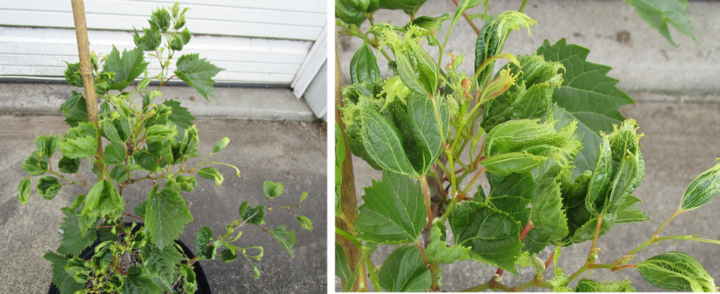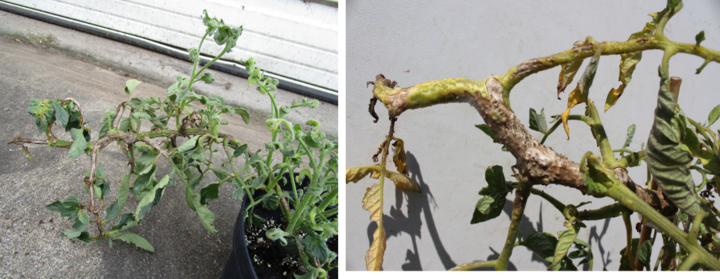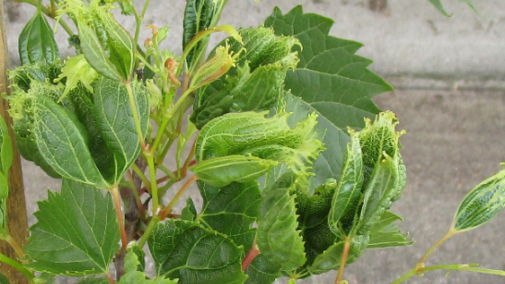Dicamba is a selective herbicide commonly used to control broadleaf weeds in pasture, rangeland, and grass crops (e.g., corn, sorghum, wheat). With the commercialization of dicamba-tolerant (DT) soybeans, use of dicamba for weed control is increasing, along with the number of cases of unintended drift during application. This is of great concern to many landowners and land managers.
Environmental conditions such as wind and temperature inversion during applications can move spray droplets or volatilized (even 36 hours after application) dicamba off-target, injuring nearby sensitive crops. New dicamba-based products such as Engenia and XtendiMax with Vapor Grip technology were developed to reduce volatility. Reports suggested that these new formulations were much improved versions compared to earlier products (e.g., Clarity, Banvel); however, they still can vaporize significantly, creating a risk of off-target movement.
Grape and Tomato Sensitivity to Dicamba
It's estimated that Nebraska has more than 400 acres of commercial grape production divided among a number of sites.
Grapes and tomatoes (as well as other fruits and vegetables) are known to be sensitive to dicamba. Grape is an important crop in the United States with over 900,000 acres grown in 2016, yielding 7.7 million tons of fruit. Grapes are commonly planted in small plots at local acreages and countrysides for local markets or home use. Off-target movement of dicamba from surrounding fields could be a threat to grape production. United States is among the top five producers of tomato globally. In 2016, tomatoes were grown on 364,799 acres with net worth of about $2.1 billion.
We wanted to confirm the level of sensitivity of both crops to low rates of dicamba. Therefore, we conducted studies during the summers of 2016 and 2017 at the Haskell Ag Lab near Concord to evaluate dicamba’s effects on the growth of pot-grown grape and tomato. Frontenac grape and Better Boy tomato were the varieties used for the experiment. Two-year-old grape bare rootstocks (about 12 inches) and tomato seedlings (about 5 inches) were planted into 10-by-10-inch pots filled with moisture-control potting mix and watered as needed. They were sprayed with three dicamba-based herbicides (Clarity, Engenia and XtendiMax) at the micro-rates of 0, 1/10, 1/50, 1/100, 1/500, and 1/1000 of the label rate. The label rate of Clarity, Engenia and XtendiMax were 16, 12.8, and 22 oz/acre, respectively.
To help visualize the rates, 1/10 of the label rate is equivalent to three tablespoons; 1/100th is equal to one teaspoon applied over a size of a football field (one acre). Tomatoes were 10 inches tall at time of application and the grape vines were 25 inches long. Visual injuries rated on a scale of 0 (no injury) to 100 (dead plant) were collected at 7, 14, 21 and 28 days after treatment (DAT). Maximum accumulated vine length of grape, plant height of tomato, and plant biomass of both species were collected at 28 DAT. Plants were not grown for fruit yields.
In general, results showed that all three dicamba herbicides similarly impacted growth of grape and tomato. The observed injury symptoms in grapes were in the form of leaf and stem twisting and leaf cupping (Figure 1). Visual injury in grapes ranged from 20% to 64%, depending on the dicamba rate. For example, 1/100 and 1/10 of the label rate caused about 35% and 64% visual injury, respectively, at 21 DAT. The reduction in vine length increased from 5% to 40% with the increase in dicamba micro-rates from 1/1000 to 1/10 of the label rate.
Similarly, the injury levels on the tomato plants increased with the increase in dicamba micro-rates. The observed injury symptoms in the tomato plants were in the form of stunting, chlorosis, callus-like formation on main-stem, and cupping and curling of leaves (Figure 2). Injury increased from 20% to 80% as the dicamba rate increased from 1/1000 to 1/10 of the label rate. The 1/100 of the label rates were enough to cause 50% injury in the tomato plant. Plant height was reduced by 10%-50% (~ 3 to 20 inches) by increasing the dicamba rate from 1/1000 to 1/10 of the label rate. For example, applying Clarity at 1/100 of the label rate (0.16 oz/acre) reduced tomato height from 31 inches to 23 inches. Other dicamba products had a similar impact on tomato plant height. The injury and growth reduction caused by micro-rates of dicamba products could also reduce tomato yields. Kruger et al. (2012) reported that exposure to 1/50 of dicamba label rate caused a 25% reduction in tomato yield when applied at early vegetative stage.
In general, our study showed that grape and tomato were very sensitive to micro-rates of all three dicamba herbicides, therefore off-target movement of dicamba must be prevented.


Applicators:
Before spraying pesticides, check FieldWatch™ to determine the location of potentially sensitive commercial crops being grown in the area. Local homeowners, acreage owners and gardeners may have sensitive plants not indicated on FieldWatch.
Growers:
If you're growing commercial grapes, tomatoes or other potentially sensitive plants, list them in DriftWatch™ so applicators can learn their location.

